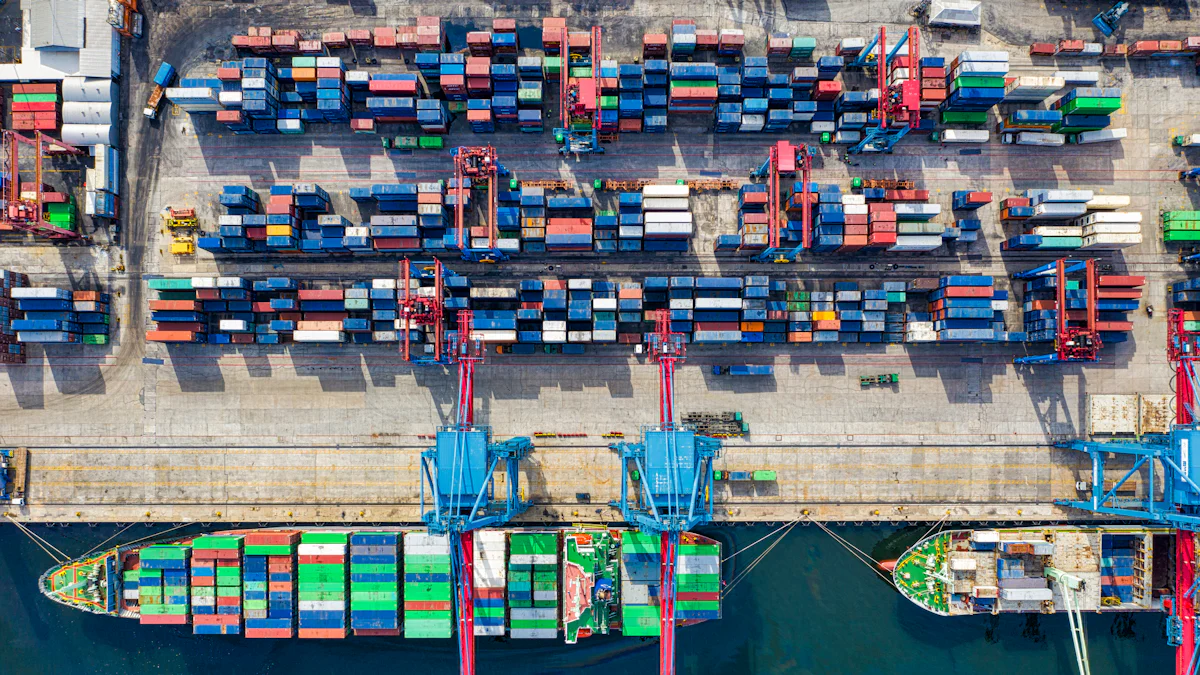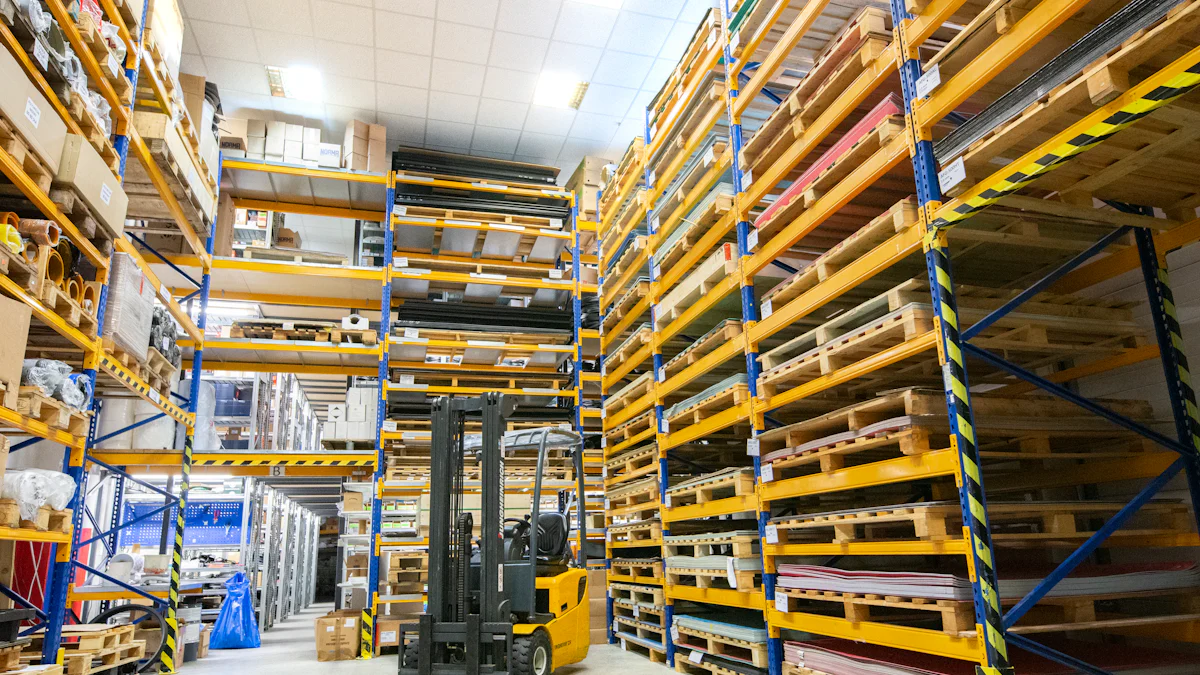Digital Transformation in Logistics: A 5-Year Market Forecast

Digital transformation in logistics revolutionizes the industry by integrating advanced technologies such as IoT, AI, and robotics. Companies adopt these innovations to streamline operations, enhance efficiency, and reduce costs. Understanding market forecasts becomes crucial for businesses aiming to stay competitive and craft effective strategies. This blog aims to provide a comprehensive analysis of the digital transformation market in logistics over the next five years.
Key Players in the Market
Major Companies
Global Leaders
Global leaders in logistics drive digital transformation through significant investments in technology. Companies like DHL, FedEx, and UPS lead the market with advanced solutions. These companies integrate IoT, AI, and robotics to enhance operational efficiency. DHL focuses on smart warehouses and real-time tracking systems. FedEx invests heavily in autonomous delivery vehicles and predictive analytics. UPS leverages big data and machine learning for route optimization.
Emerging Players
Emerging players disrupt the logistics market with innovative approaches. Startups such as Flexport and Convoy gain traction by offering digital-first solutions. Flexport provides a cloud-based platform for global trade management. Convoy uses AI to match shippers with carriers, optimizing load efficiency. These companies challenge established players by embracing agility and innovation.
Technological Innovators
Software Providers
Software providers play a crucial role in digital transformation. Companies like SAP, Oracle, and Manhattan Associates offer comprehensive logistics software solutions. SAP delivers integrated supply chain management systems. Oracle provides cloud-based logistics platforms for real-time visibility. Manhattan Associates specializes in warehouse management systems and transportation management software.
Hardware Manufacturers
Hardware manufacturers contribute to the logistics industry's digital shift. Companies such as Zebra Technologies and Honeywell produce essential hardware. Zebra Technologies offers barcode scanners and RFID solutions for inventory management. Honeywell manufactures rugged mobile computers and wearable devices for warehouse operations. These hardware solutions enable seamless integration with software platforms, enhancing overall efficiency.
Digital Transformation Market Insights and Analysis
Current Market Size
Revenue Statistics
The digital transformation market in logistics has shown significant growth. In 2023, the market size reached $57.2 billion. Projections indicate that the market will grow to $120.33 billion by 2032. This growth reflects a compound annual growth rate (CAGR) of 17.8%. The roadways segment held the majority share in 2021, contributing around 52% of the logistics market revenue. The supply chain solutions segment accounted for the largest revenue share of 35.57% in 2022.
Market Share Distribution
The market share distribution highlights regional differences. North America leads with substantial investments in technology. Europe holds the second-largest market share. The region's growth is fueled by expanding e-commerce trends. European countries finance logistics research and development. The Asia-Pacific region shows rapid adoption of digital transformation. This region benefits from increasing industrialization and urbanization.
Market Trends
Adoption Rates
Adoption rates of digital transformation technologies continue to rise. Companies prioritize integrating IoT, AI, and robotics. The logistics industry sees a surge in the use of autonomous vehicles and drones. Predictive analytics and real-time tracking systems gain popularity. Businesses seek to enhance operational efficiency and reduce costs. The adoption of digital transformation creates $1.5 trillion in value for businesses by 2023.
Technological Advancements
Technological advancements drive the digital transformation market. Big Data, Artificial Intelligence, and Machine Learning revolutionize logistics. Blockchain and Cloud Computing offer enhanced security and scalability. IoT enables real-time tracking and supply chain visibility. Robotics and automation streamline warehousing operations. These advancements contribute to the market's robust growth.
Factors Driving Market Growth
Technological Advancements
AI and Machine Learning
Artificial Intelligence (AI) and Machine Learning (ML) technologies transform logistics operations. AI-driven analytics enhance decision-making by providing real-time data insights. Predictive analytics improve demand forecasting accuracy by analyzing vast amounts of data. Intelligent route planning optimizes delivery schedules, reducing fuel consumption and operational costs. Smart warehouse management systems streamline inventory control and order fulfillment processes. These advancements contribute to improved operational efficiency and customer experiences.
IoT and Connectivity
The Internet of Things (IoT) revolutionizes logistics by enabling real-time monitoring of vehicles and assets. IoT devices provide continuous data streams, enhancing supply chain visibility. Real-time tracking systems allow companies to monitor shipments and predict arrival times accurately. Improved connectivity facilitates seamless communication between different logistics components. IoT integration with AI enables predictive maintenance, reducing downtime and enhancing asset utilization. These innovations drive the logistics industry's digital transformation.
Economic Factors
Cost Efficiency
Digital transformation in logistics significantly enhances cost efficiency. Automation reduces labor costs by streamlining repetitive tasks. AI-powered systems optimize resource allocation, minimizing waste and improving productivity. Predictive analytics help companies anticipate demand fluctuations, reducing inventory holding costs. Real-time tracking systems minimize delays and disruptions, lowering operational expenses. These cost-saving measures contribute to the overall growth of the digital logistics market.
Global Trade Dynamics
Global trade dynamics play a crucial role in driving digital transformation in logistics. Increasing globalization and cross-border trade necessitate efficient logistics solutions. Digital technologies enable companies to manage complex international supply chains effectively. Enhanced connectivity and real-time data exchange facilitate smoother customs clearance processes. Predictive analytics help companies navigate fluctuating trade regulations and tariffs. These factors underscore the importance of digital transformation in maintaining competitive advantage in the global market.
Types of Digital Transformation in Logistics

Automation
Robotics in Warehousing
Robotics revolutionizes warehousing by automating repetitive tasks. Robots handle picking, packing, and sorting with precision. This technology reduces human error and increases productivity. Automated Guided Vehicles (AGVs) transport goods within warehouses efficiently. These robots navigate using sensors and cameras, ensuring safety. Companies like Amazon and Ocado lead in robotic warehousing solutions. The integration of robotics enhances operational efficiency and reduces labor costs.
Autonomous Vehicles
Autonomous vehicles transform logistics by enabling self-driving trucks and delivery drones. These vehicles operate without human intervention, reducing the need for drivers. Waymo and Tesla develop cutting-edge autonomous trucks. These trucks use AI and machine learning for route optimization. Amazon Prime Air pioneers drone delivery services. Drones deliver packages quickly and efficiently, especially in remote areas. Autonomous vehicles enhance delivery speed and reduce transportation costs.
Data Analytics
Predictive Analytics
Predictive analytics uses historical data to forecast future trends. This technology helps logistics companies anticipate demand fluctuations. Companies use predictive analytics for inventory management and demand planning. AI-driven analytics provide real-time data insights, improving decision-making. Predictive analytics enhances supply chain visibility and reduces stockouts. This technology optimizes resource allocation and minimizes waste.
Real-time Tracking
Real-time tracking provides continuous monitoring of shipments and assets. IoT devices enable real-time data collection and transmission. Companies use real-time tracking for fleet management and route planning. GPS technology ensures accurate location tracking of vehicles. Real-time tracking systems predict arrival times and reduce delays. This technology enhances customer satisfaction by providing transparency. Zebra Technologies and Honeywell offer advanced tracking solutions.
Regional Outlook

North America
Market Size and Growth
North America leads the digital transformation in logistics market. The region accounted for USD 433,251.42 million in 2021. Projections indicate significant CAGR growth over the next five years. The adoption of advanced technologies drives this expansion. Companies invest heavily in IoT, AI, and robotics to enhance operational efficiency.
Key Players
Key players in North America include DHL, FedEx, and UPS. These companies leverage cutting-edge technologies to maintain a competitive edge. DHL focuses on smart warehouses and real-time tracking systems. FedEx invests in autonomous delivery vehicles and predictive analytics. UPS utilizes big data and machine learning for route optimization.
Europe
Market Size and Growth
Europe holds the second-largest market share in digital transformation in logistics. The region's growth stems from expanding e-commerce trends. European countries finance logistics research and development. The market size continues to grow as companies adopt new technologies. The region shows a steady increase in the use of IoT and AI.
Key Players
Prominent players in Europe include DB Schenker, Kuehne + Nagel, and Geodis. DB Schenker integrates IoT for enhanced supply chain visibility. Kuehne + Nagel employs AI for demand forecasting and inventory management. Geodis uses robotics to automate warehousing operations. These companies drive the region's digital transformation.
Asia-Pacific
Market Size and Growth
Asia-Pacific exhibits the highest growth rate in digital transformation in logistics. The market was valued at USD 3,952.34 billion in 2023. The region shows a CAGR of 10.45% over the forecast period. Rapid industrialization and urbanization fuel this growth. Companies in Asia-Pacific rapidly adopt digital technologies to stay competitive.
Key Players
Key players in Asia-Pacific include Nippon Express, Sinotrans, and Yusen Logistics. Nippon Express leverages IoT for real-time tracking and monitoring. Sinotrans integrates AI for route optimization and predictive maintenance. Yusen Logistics uses data analytics to enhance supply chain efficiency. These companies lead the region's digital transformation efforts.
The analysis highlights significant growth in digital transformation within logistics. Key players leverage advanced technologies to enhance efficiency and reduce costs. Stakeholders must invest in IoT, AI, and robotics to remain competitive. The market shows promising expansion, driven by technological advancements and economic factors. Future strategies should focus on adopting innovative solutions and optimizing supply chain operations. Companies must prioritize real-time tracking and predictive analytics to stay ahead. The logistics industry will continue evolving, offering new opportunities for growth and innovation.
See Also
5 Key Trends Shaping Future Supply Chain Efficiency
Navigating Tomorrow's Logistics Using Digital Innovation
Tomorrow's Logistics Revolutionized by AI in Supply Chain
